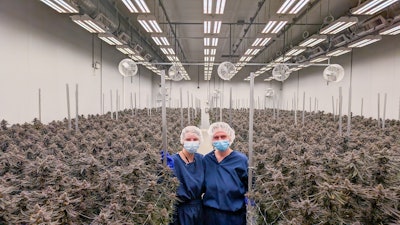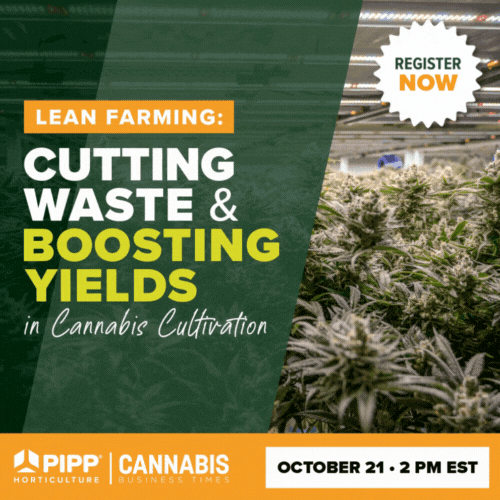
When the legacy growers at Nova Scotia’s EastCann craft licensed producer (LP) outgrew the footprint of their Dartmouth facility, the Canadian group looked to expand. But they weren’t interested in distressed cannabis businesses. Director of Cultivation Sean MacDougall explains the group focused on finding a facility in good condition, with a great team and functioning systems—one that fit with the EastCann ethos.
“We have a very culture-based leadership team. A lot of people came from the cannabis industry and have a great relationship with it and maintain that. … We are definitely invested in the product. We let our product speak for itself and set the tone,” MacDougall says.
They found the acquisition they were looking for, AtlantiCann Medical Inc. (AMI), 20 minutes away in Sackville.
“At the time, in 2023, a lot of facilities were having troubles and closing or being bought,” MacDougall says. “This facility had everything running. Every part of the chain here at AtlantiCann was working for us.”
But the new facility had one thing missing: lighting that met the standards of MacDougall and the company’s head of infrastructure improvements and master grower, Matt Casey. Flower rooms at the new facility were still running HPS, and other rooms, while not HPS, were still outdated for MacDougall’s and Casey’s objectives.
“From day one to harvest, everything is a race to build the strongest root base in the lifecycle. You need the best equipment behind you to drive that.” — Matt Casey
As Casey explains, “The mother rooms and the veg rooms were already on LEDs. They were just older technology and not the quality that we need in order to grow cannabis. From day one to harvest, everything is a race to build the strongest root base in the lifecycle. You need the best equipment behind you to drive that.”
Leaning Into Improved LED Technology
MacDougall shares that when he and Casey started with the EastCann facility in Dartmouth several years ago, the grow had old-style LED lighting in place.
“We had the old ‘blurple’ lights [at EastCann], kind of the first generation that licensed producers bought when they were getting started,” he says.
The team grew two crops with the old lights before launching an upgrade to newer LED technology. They decided to install Fluence LED lighting solutions, specifically SPYDRs. But the vendor vetting was fairly easy: MacDougall and Casey had both been putting the manufacturer’s lighting in other facilities dating back many years, prior to joining EastCann.
Their confidence was confirmed with the EastCann lighting upgrade. “When we switched, we saw a drastic increase in yield right away. From that point on, we pretty much picked our light and we’ve been sticking with it. It’s been a good transition that way,” MacDougall says.
After the EastCann retrofit, the group’s Origin grow in Sydney, Nova Scotia, was next to make the switch to new-generation LEDs. The AMI facility is the third facility the team has retrofitted with new LEDs in the last three years.
“We’re always trying to optimize our growing techniques by using the tools that are out there for us,” MacDougall adds.
Raising AtlantiCann Medical Inc.’s Standards
The AMI lighting retrofit is still in process, but the 90,000-square-foot facility is well on its way. “AMI was built in two phases. So, we have a Phase One and a Phase Two,” Casey explains. “Currently, Phase One has been 100% retrofitted. And when I'm saying that, I mean it's not just our flower rooms. Our veg rooms, our mother rooms, all the rooms have been outfitted with Fluence LEDs.”
For the 12 flower rooms, the team made the decision to do a 1:1 retrofit from the existing HPS lighting to Fluence RAPTR fixtures. “We chose to do one-to-one replacements here at AMI simply because we have the ceiling space for it. With massive ceilings—sitting at 18 feet—we have a lot of room to be able to do one-to-ones,” Casey adds.
The grow’s switch from HPS to LEDs in flower was as simple and as fast as a 1:1 retrofit sounds like it should be. MacDougall says, “Our turnaround on taking the other lights down and putting the new ones up was a three-day turnaround. Everything worked great. That’s what we needed to have happen, and it did.”
Improving Results and Profitability
AMI’s Phase One retrofit results fulfilled expectations. “We have seen an increase in production—some cultivars are up to a 30-percent increase, some a 10-percent increase—very, very much cultivar dependent,” Casey says.
He also says the team has seen more robust stalk growth and faster response times in plants.
Then there are also power and HVAC savings with the switch from HPS to new-generation LED technology. It all equates to more profitability for the company, an essential consideration in what Casey describes as the highly taxed Canadian market.
“It really comes down to the primary question: Why LEDs for us? It is a way to produce a really high-quality cannabis and maintain a business structure on your cost per gram to grow,” Casey says.
Focusing on Quality and Consistency
While some would describe the Canadian market’s last several years as a roller coaster, MacDougall says the country’s early national legalization gave it a unique position as the European Union opened up to legal cannabis imports.
“It all started the same, where there was a black market and there was a legal space, and people were thinking the legal space wasn’t going to be able to produce the quality,” he says, adding that the quality actually came quickly. The key was to find a home for the products that were grown. And for the EU GMP-certified facility, that home has increasingly been abroad.
MacDougall says the team is focused on the highest-level quality possible for medical-grade products and medical-grade cannabis: “We play in a very high-quality flower space. In the international market, in the domestic market, our focus is on high-end quality flower. We grow fresh-frozen, but it's the same garden that we would use for flower. We just use high-end flower in our fresh-frozen input.”
Consistency in production is key to remaining competitive in the high-end market MacDougall says, noting that lighting is essential to those results: “We’re able to harvest every week. … It’s like Groundhog Day, and it continues all the time. Our goal is to grow 52 gardens a year and continually have that consistency and quality.”
Experiencing Service—and Results
Casey looks back on the retrofits at EastCann and Origin from “blurple” lights to full spectrum Fluence LEDs. “I outfitted those two facilities, and we had extremely good results,” he says. “But why I went with Fluence again at AMI was because of service.”
With Fluence support, Casey says he’s been able to pick up a phone whenever he’s had issues, actually talk to somebody live, and get either direction or resolution of the issue that day.
“When it comes to cannabis, service is massive. It’s king. If you can't provide good quality service, to me, you shouldn't be selling lights to begin with,” he says. “That was one of the driving points, and that has carried on throughout the years, and that's why I put in more and more Fluence in several other facilities now.”
More from our latest newsletter:
Sponsored: Top 5 Things to Know to Start a Commercial Cannabis Grow
Sponsored: The New VYPR 4: Optimized Spectrum, Proven Performance


